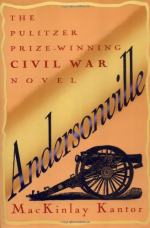The great tunneling tool was the indispensable half-canteen. The inventive genius of our people, stimulated by the war, produced nothing for the comfort and effectiveness of the soldier equal in usefulness to this humble and unrecognized utensil. It will be remembered that a canteen was composed of two pieces of tin struck up into the shape of saucers, and soldered together at the edges. After a soldier had been in the field a little while, and thrown away or lost the curious and complicated kitchen furniture he started out with, he found that by melting the halves of his canteen apart, he had a vessel much handier in every way than any he had parted with. It could be used for anything —to make soup or coffee in, bake bread, brown coffee, stew vegetables, etc., etc. A sufficient handle was made with a split stick. When the cooking was done, the handle was thrown away, and the half canteen slipped out of the road into the haversack. There seemed to be no end of the uses to which this ever-ready disk of blackened sheet iron could be turned. Several instances are on record where infantry regiments, with no other tools than this, covered themselves on the field with quite respectable rifle pits.
The starting point of a tunnel was always some tent close to the Dead Line, and sufficiently well closed to screen the operations from the sight of the guards near by. The party engaged in the work organized by giving every man a number to secure the proper apportionment of the labor. Number One began digging with his half canteen. After he had worked until tired, he came out, and Number Two took his place, and so on. The tunnel was simply a round, rat-like burrow, a little larger than a man’s body. The digger lay on his stomach, dug ahead of him, threw the dirt under him, and worked it back with his feet till the man behind him, also lying on his stomach, could catch it and work it back to the next. As the tunnel lengthened the number of men behind each other in this way had to be increased, so that in a tunnel seventy-five feet long there would be from eight to ten men lying one behind the other. When the dirt was pushed back to the mouth of the tunnel it was taken up in improvised bags, made by tying up the bottoms of pantaloon legs, carried to the Swamp, and emptied. The work in the tunnel was very exhausting, and the digger had to be relieved every half-hour.
The greatest trouble was to carry the tunnel forward in a straight line. As nearly everybody dug most of the time with the right hand, there was an almost irresistible tendency to make the course veer to the left. The first tunnel I was connected with was a ludicrous illustration of this. About twenty of us had devoted our nights for over a week to the prolongation of a burrow. We had not yet reached the Stockade, which astonished us, as measurement with a string showed that we had gone nearly twice the distance necessary for the purpose. The thing




